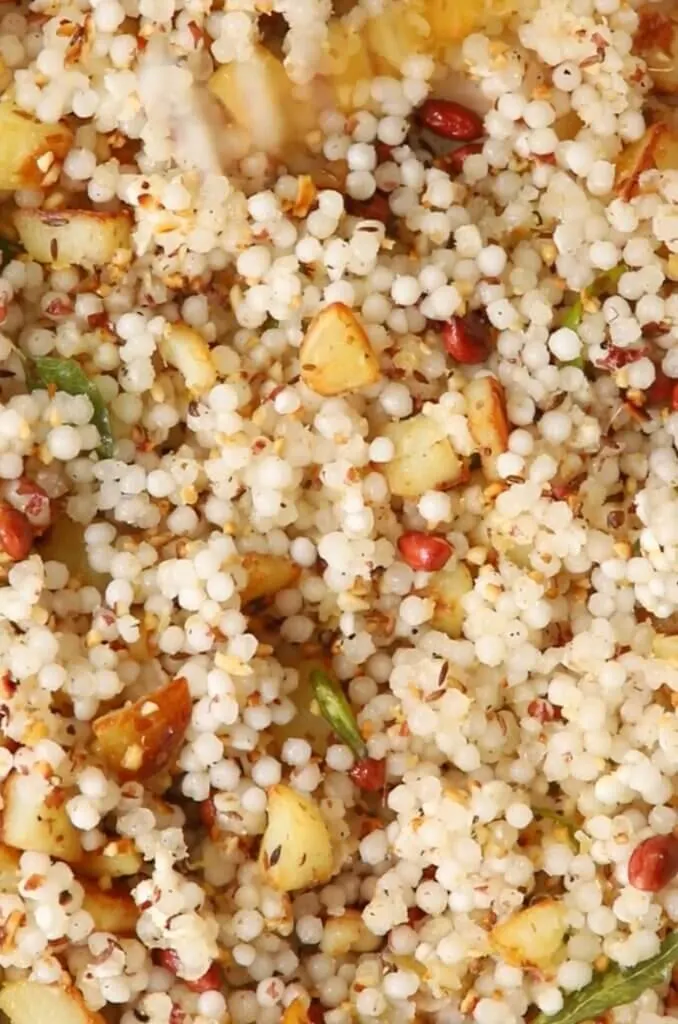Learn how to make Classic Sabudana Khichdi with me!
This is a delicious recipe for the famous Indian snack, Sabudana Khichdi.
It’s a savoury snack made with chewy tapioca pearls, potatoes, peanuts and spices.
One bite and you’ll be hooked.
Sabudana Khichdi is a traditional dish famed throughout India from Gujarat and Rajasthan, to Maharashtra, Uttar Pradesh, Madhya Pradesh and Karnataka.
Comforting carb-on-carb food.
Let me explain.
What is Sabudana Khichdi?
This is a dish that is typically enjoyed during religious fasts (ekadasi fasting or vrat).
These are in line with the Hindu calendar’s religious fasting days like Ekadashi, Navratri, Janmashtami, and Mahashivratri.
It’s delicious and keeps you full for a long time.
It is a popular choice for fasting (upvas) but can be enjoyed at any time.
It’s easily veganised, has no onions and garlic, and is suitable for a gluten-free diet.


What are sabudana?
Tapioca pearls (sabudana or साबूदाना in Hindi) are made from the starch extracted from cassava root.
They’re popular in a number of cuisines, but are a staple fasting ingredient across India.
You can buy them in a number of different sizes. I’ve opted for medium-sized pearls in my recipe, about 2mm round.
They are rich in carbohydrates and are known to give a quick boost of energy during fasts.
If you choose to use large sabudana, you’ll need to double the amount of water and yoghurt.
It will also take longer to cook.
I do not recommend using small sabudana for this khichdi.
It will become very mushy and soft (unless that’s how you like it).
I have a nut allergy. Can I omit the peanuts?
You certainly can.
How to make vegan Sabudana Khichdi
Simply switch the yoghurt in this recipe with your favourite plant-based yoghurt alternative and add an extra squeeze of lemon juice at the end.
Enjoy this recipe for breakfast, lunch, dinner, or at any time between then!

How to make Classic Sabudana Khichdi
Recipe card with measurements below.
1. Wash and soak the saubdana

Place the sabudana (tapioca pearls) in a sieve and wash well in cold water until the water runs clear.
In a large bowl, whisk together the yoghurt and water.
Next, add the saubdana and stir to coat.
Cover and refrigerate overnight, or for 6 hours.
2. Prepare the potatoes

Peel and dice the potatoes into 1cm x 1cm cubes.
Place in a bowl and cover with cold water until required.
3. Grind the peanuts



Coarsely grind 50g of the the peanuts (you can reserve the rest for garnishing later).
4. Cook the khichdi

Heat the ghee in a large non-stick pan.
Add the cumin seeds and 5-6 curry leaves (fry the rest and use for garnishing or add them all at this stage).

Allow to sizzle for a few moments before adding the drained potatoes.

Cook over a medium heat, stirring often, until the potatoes brown and are tender.

Add the ground peanuts, chillies, ginger, salt (use rock salt ‘sendha namak’ if you’re fasting) and black pepper.
Cook for a further 5 minutes.

Add the soaked sabudana and stir well. Add the additional 30g whole peanuts, black pepper, fresh coriander and lemon juice.

Cover with a lid and cook over a low heat for 15 minutes, or until the sabudana are tender.

Don’t cook this over a high heat or the sabudana will become very tough and chewy.
Some may turn a little translucent – this is fine.
Do not add any additional water during the cooking process and halfway through to prevent the khichdi burning on the base of the pan.
5. Garnish the Sabudana Khichdi

Uncover and toss to combine once more.
You can also garnish with fried curry leaves, if desired.
Serve the Khichdi immediately

Finally, serve the Sabudana Khichdi hot with cold plain yoghurt.
Classic Sabudana Khichdi recipe card
Classic Sabudana Khichdi

A delicious recipe for the famous Indian snack, Sabudana Khichdi. This is a savoury snack made with chewy tapioca pearls, potatoes, peanuts and spices. One bite and you'll be hooked.
Ingredients
- 300g sabudana (medium-sized tapioca pearls), washed until the water runs clear)
- 50g sour plain yoghurt
- 125ml cold water
- 65g ghee
- 2 tsp cumin seeds
- 3 green chillies, sliced
- 15 curry leaves
- 1 tbsp minced ginger
- 500g potatoes, peeled and cubed
- 80g roasted peanuts (unsalted), divided
- 1 1/2 tsp rock salt
- 1 tsp ground black pepper
- 2-3 tbsp fresh coriander, chopped
- Squeeze of lemon juice
Instructions
- Place the sabudana (tapioca pearls) in a sieve and wash well in cold water until the water runs clear.
- In a large bowl, whisk together the yoghurt and water. Add the saubdana and stir to coat. Cover and refrigerate overnight, or for 8 hours.
- Peel and dice the potatoes into 1cm x 1cm cubes. Place in a bowl and cover with cold water until required. This will stop them turning brown.
- Coarsely grind 50g of the the peanuts (you can reserve the rest for garnishing later).
- Heat the ghee in a large non-stick pan. Add the cumin seeds and 5-6 curry leaves (fry the rest and use for garnishing or add them all at this stage). Allow to sizzle for a few moments before adding the drained potatoes. Cook over a medium heat, stirring often, until the potatoes brown and are tender.
- Add the ground peanuts, chillies, ginger, salt and black pepper. Cook for a further 5 minutes.
- Add the soaked sabudana and stir well. Cover with a lid and cook over a low heat for 15 minutes, or until the sabudana are tender. Some may turn a little translucent - this is fine. Do not add any additional water during the cooking process and halfway through to prevent the khichdi burning on the base of the pan.
- Uncover and toss to combine once more. Add the additional 30g whole peanuts, black pepper, fresh coriander and lemon juice. You can also garnish with fried curry leaves, if desired.
- Serve hot with cold plain yoghurt.
Notes
Sabudana come in different sizes. This Khichdi is typically made with the medium size. If you choose to use large sabudana, you'll need to double the amount of water and yoghurt. It will also take longer to cook.
I do not recommend using small sabudana for this khichdi. It will become very mushy and soft (unless that's how you like it).
If your sabudana are too firm and chewy for your taste after the required cooking time, you can splash it with no more than a tablespoon of water and continue to cook with the lid on for a further 5 minutes.
Fried curry leaves are optional but delicious.
You can replace the peanuts with cashews or omit the nuts entirely.
For a vegan version, use your favourite plant based yoghurt and add a little extra lemon juice at the end.
If you like this, you’ll love my recipe for Sabudana Vada

Love Sanjana


Village-Style Gujarati Khichdi (Buttery Rice & Lentils) - Sanjana.Feasts - Gujarati Cooking
Monday 27th of March 2023
[…] Sabudana ni Khichdi […]